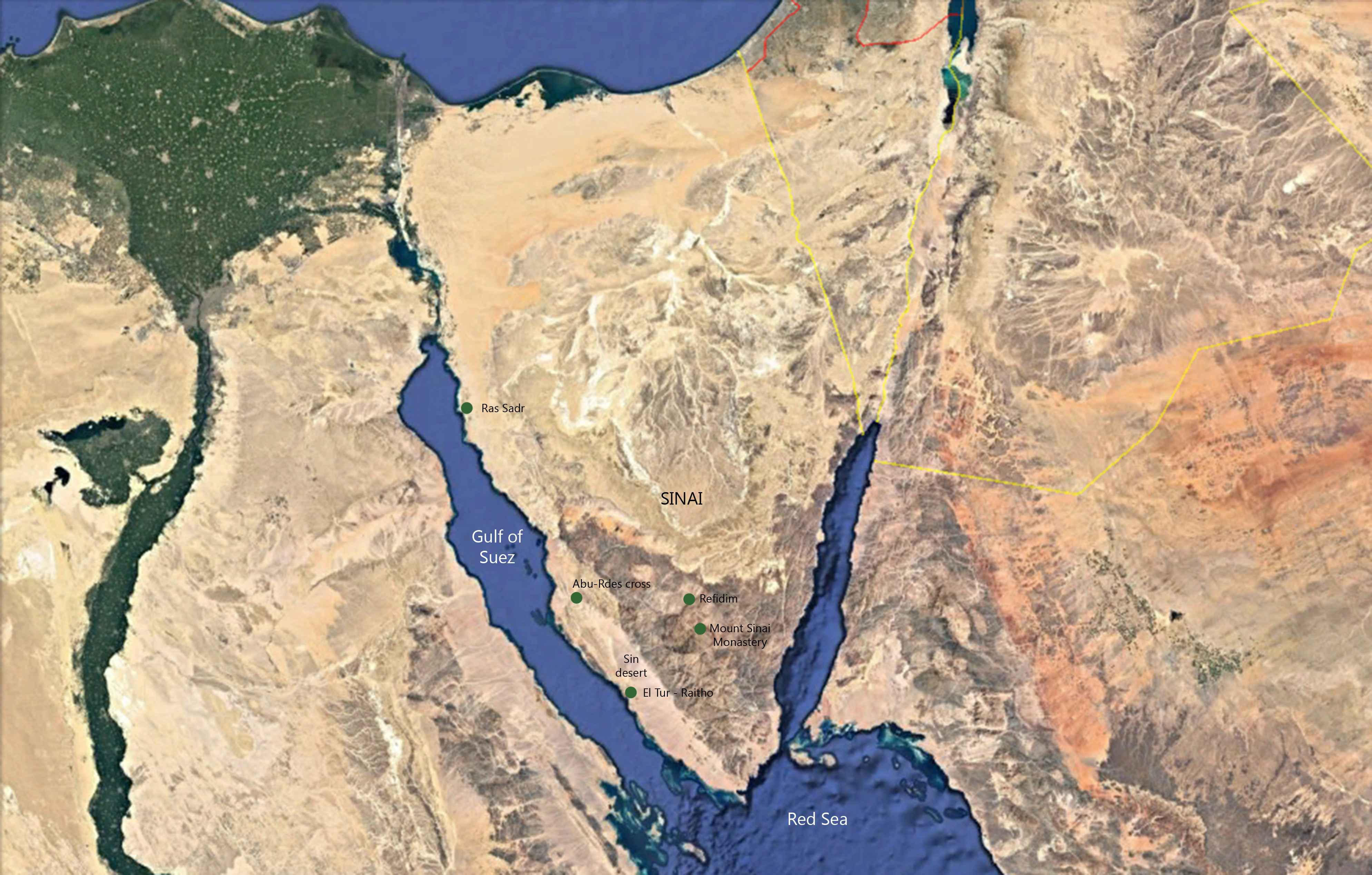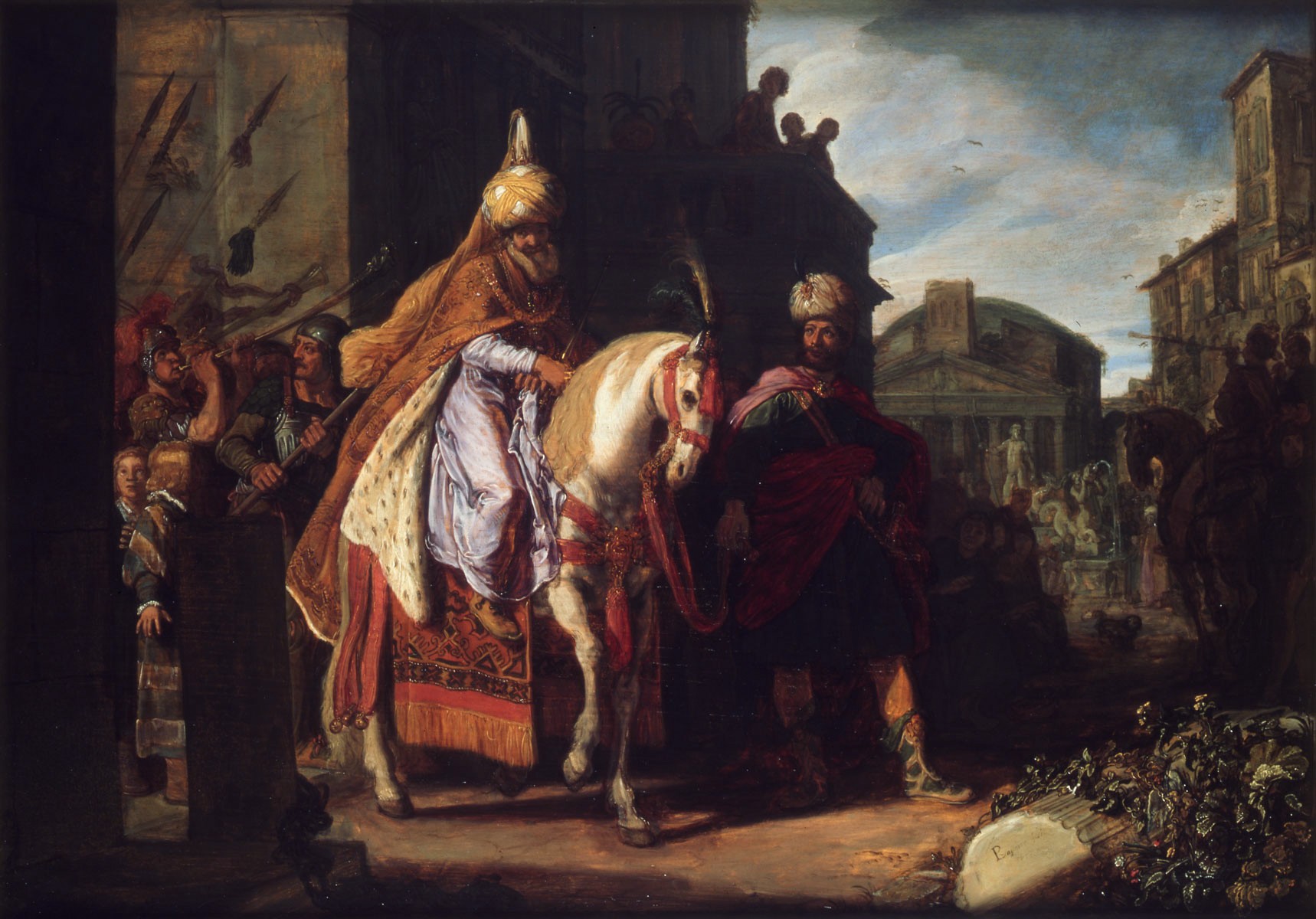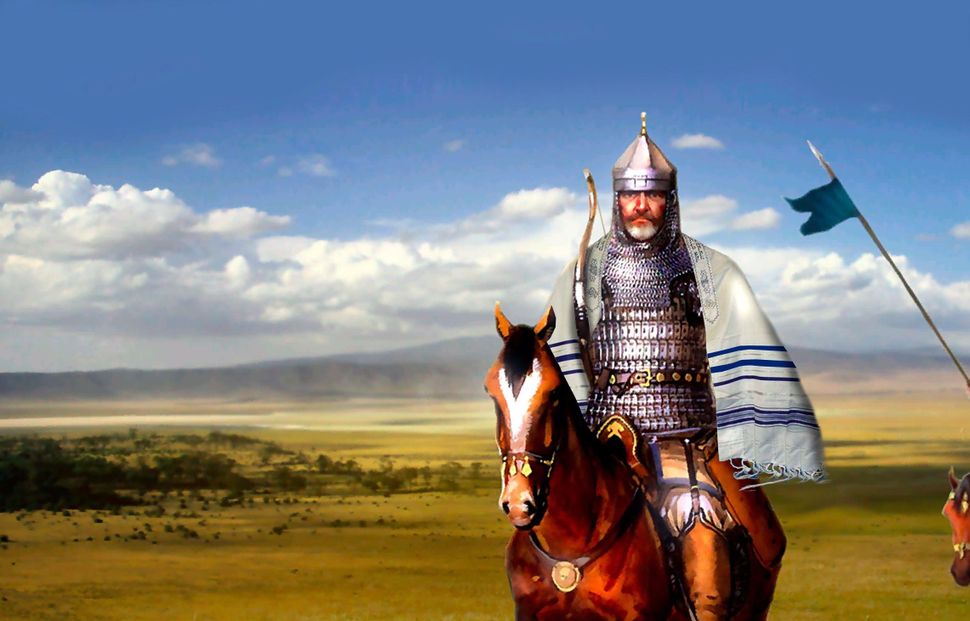Overview: A discussion on the different opinions and archeological evidence for the origins of the Israelite God YHWH, as well as a discussion of how to square it with belief in Judaism.
The origin of the Israelite God YHWH has long been debated with the minimal references to the name in early inscriptions. As such, some have hypothesized that the God YHWH originated in Northern Israel, while a more widely accepted view suggests a Southern conception of the God YHWH. The latter opinion proposes, based on inscriptions found, that tribes in Edom and Midian have long served YHWH and the Israelites imported their God from these tribes located in the Southern Levant. We will examine both these theories and see if and how they can fit with a belief in Torah as divinely-inspired.
The Moabite stone
The earliest undisputed extra-biblical mention of YHWH as a deity appears in what’s known as the Moabite Stone, or the Mesha Stele. In this 9th-century royal inscription from the King of Moab, he brags about his victories against the Israelites and their God YHWH. No other deity is mentioned with the Israelites.
Here is an excerpt from the text.
“And Chemosh [the Moabite national-god] said to me [king Mesha of Moab], Go take Nebo against Israel, and I went in the night and I fought against it from the break of day till noon, and I took it: and I killed in all seven thousand men, but I did not kill the women and maidens, for I devoted them to Ashtar-Chemosh; and I took from it the vessels of YHWH, and offered them before Chemosh.”
Kuntillet Ajrud
Deep into the Northeastern Sinai desert lie a priestly cultic site dating back to the 8th-century BCE. At this site several inscriptions were found telling us much about the people who once occupied this sanctuary in Kuntillet Ajrud, once a major station along the desert route. Along with other deities such as Baal and EL, mention is made of “YHWH of Samaria and His Asherah” using the Hebrew language. Samaria was the capital of the Northern Kingdom of Israel at that time and Asherah was the goddess, who according to the Ugaritic pantheon married EL, the Supreme God associated with YHWH throughout Tanakh. Another mention is made of YHWH of Teman. Right beneath this inscription was a drawing of an apparent god with a penis or tale, alongside his wife and a bull.[1] Clearly, the Israelites responsible for these inscriptions and drawings worshipped a deity named YHWH despite their idol-worshipping. The description of YHWH of Samaria suggests that YHWH was associated with the Northern Kingdom which worshipped YHWH in addition to Baal and Asherah.
The bull in the image is one of many references to EL as a bull (Tôru ‘Ēl) in Canaanite texts. The Israelites often associated EL or YHWH with a bull. King Jeroboam sets up golden calves in the Northern cities Dan and Bethel for his subjects to worship.[2] Similarly, after the Israelites leave Egypt they worship the Golden Calf, according to the book of Exodus.[3] Papyrus Amherst 63, soon to be discussed, also calls YHWH “our Bull.”
The reference to Teman in the inscription is unclear since no such God appears in that region. But it has been hypothesized by many scholars that YHWH originated in Teman, otherwise known as Edom or Seir.[4] While this is mostly conjecture, there is some evidence supporting their claim although no definitive conclusions can be made. We will examine more about Teman as the source for YHWH later in the article.
Papyrus Amherst 63
Dated to the 4th-century BCE, Papyrus Amherst 63 was likely written by the descendants of Aramean and Judean soldiers who had been stationed at the Egyptian border. In this fascinating inscription, they speak of their traditions dating back to 7th-century Samaria in Northern Israel. In these psalms, they invoke the name EL, YHWH, Baal, Baal-Shamin, and Bethel – all gods in the idol-worshipping Northern Israel during the Monarchical era. One of the many things this Papyrus teaches us about the ancient Israelites is their strong worship of their national-god YHWH despite serving other inferior gods as well. As an interesting sidenote, one of the three Psalms in the Papyrus is what appears to be an identical version to our current Psalm Ch. 20; except that it invokes pagan gods as well.[5] It also makes mention of the New Years holiday of Rosh Hashanah and the sacrifices offered on that day.
Shasu of yahu(w)
Two Egyptian inscriptions make mention of the “Shasu of Yahu (or yhw[6])” – apparently their place of dwelling.[7] The Shasu were semi-nomadic tribes mostly in the Southern Levant and are frequently attested to in Egyptian texts. Many scholars believe that this dwelling place of theirs is a toponym for a deity they worshipped named Yahu(w), or YHWH.[8] The practice of naming cities after a god they worshiped was somewhat common at the time, with one notable example being Ashur for Assyria named after their chief god Ashur. What’s interesting about these two texts is that they date to the 14th and 13th centuries BCE, before the Israelite religion began at Sinai. This leads many scholars to believe that the Israelites were influenced by a Shasu deity named YHWH and they incorporated it into their religion. The Shasu are mostly located in the Edom/Midyan region, where according to the book of Exodus Moses first met YHWH at the burning bush.[9]
In addition to the Kuntillet Ajrud reference to “Yahu of Teman” as well as the Egyptian references to the Yahu of Shasu (who also inhabited the Teman region), there are also poetic biblical verses that speak of YHWH appearing from Teman as we shall now explore.
Biblical verses on the origins of YHWH
אֶ֤רֶץ רָעָ֨שָׁה ׀ אַף־שָׁמַ֣יִם נָטְפוּ֮ מִפְּנֵ֢י אֱלֹ֫הִ֥ים זֶ֥ה סִינַ֑י מִפְּנֵ֥י אֱ֝לֹהִ֗ים אֱלֹהֵ֥י יִשְׂרָאֵֽל׃
The earth trembled, the sky rained because of God, this is Sinai, because of God, the God of Israel.
(Ps. 68:9)
אֱל֙וֹהַּ֙ מִתֵּימָ֣ן יָב֔וֹא וְקָד֥וֹשׁ מֵהַר־פָּארָ֖ן סֶ֑לָה כִּסָּ֤ה שָׁמַ֙יִם֙ הוֹד֔וֹ וּתְהִלָּת֖וֹ מָלְאָ֥ה הָאָֽרֶץ׃
God is coming from Teman, the Holy One from Mount Paran. Selah. His majesty covers the skies, His splendor fills the earth.
(Habakuk 3:3)
וַיֹּאמַ֗ר יְהֹוָ֞ה מִסִּינַ֥י בָּא֙ וְזָרַ֤ח מִשֵּׂעִיר֙ לָ֔מוֹ הוֹפִ֙יעַ֙ מֵהַ֣ר פָּארָ֔ן וְאָתָ֖ה מֵרִבְבֹ֣ת קֹ֑דֶשׁ מִימִינ֕וֹ (אשדת) [אֵ֥שׁ דָּ֖ת] לָֽמוֹ׃
He said:
YHWH came from Sinai; He shone upon them from Seir; He appeared from Mount Paran, and approached from Ribeboth-kodesh, lightning flashing at them from His right.
(Deut. 33:2)
יְהֹוָ֗ה בְּצֵאתְךָ֤ מִשֵּׂעִיר֙ בְּצַעְדְּךָ֙ מִשְּׂדֵ֣ה אֱד֔וֹם אֶ֣רֶץ רָעָ֔שָׁה גַּם־שָׁמַ֖יִם נָטָ֑פוּ גַּם־עָבִ֖ים נָ֥טְפוּ מָֽיִם׃
YHWH, when Thou didst go out of Se῾ir, when Thou didst march out of the field of Edom, the earth trembled, and the heavens dropped, the clouds also dropped water.
הָרִ֥ים נָזְל֖וּ מִפְּנֵ֣י יְהֹוָ֑ה זֶ֣ה סִינַ֔י מִפְּנֵ֕י יְהֹוָ֖ה אֱלֹהֵ֥י יִשְׂרָאֵֽל׃
The mountains melted from before YHWH, that Sinay before YHWH God of Israel.
(Jud. 5:4-5)
We can explain these place-references to be referring to specific times in Israelite history when God’s glory was present in those specific places. At Sinai, God appeared to the Israelites and the Torah was given.[10] At Edom, otherwise known as Teman, God defeated the Edomites when the Israelites waged battle against them during their sojourn in the Wilderness.[11] At Paran, the spies went out to scout the land of Canaan. Upon returning and doubting God’s abilities to defeat the powerful Canaanites, God’s wrath in the form of a plague kills out the spies and He decrees that the Israelites remain in the Wilderness for another 40 years.[12]
YHWH of Teman
We have brought three sorts of texts that speak of YHWH of Teman. The first are the biblical verses cited above. Then there’s the Kuntillet Ajrud inscription. And finally there’s the Egyptian references to YHWH of the Shasu (who also inhabited the Teman region).
There’s two possible approaches in explaining this. The first theory is that there were indeed tribes in the Teman region that worshipped YHWH. This would easily explain all three references.
The second approach is to give three separate answers to all three instances. The biblical verses that talk of Edom/Teman would be referring to the Israelite victory against the Edomites. The Egyptian reference to “Shasu of Yahu” would be merely a place-name rather than representing a deity they worshipped. And the reference to “YHWH of Teman” in the Kuntillet Ajrud inscription would be explained as “YHWH of the South.” Teman, in addition to being a place in the South, is also synonymous with South all throughout biblical literature. Thus, it can be argued that YHWH was known as a Southern God by the Northerners of Israel – the Syrians and Phoenicians.[13] Alternatively, it was called a Southern God to the Israelites since He appeared to them at Sinai, all the way South of Israel.
The first approach is arguably smoother and more plausible since it appeals to one answer that explains all three instances, while the second approach assumes three different answers for the three instances. We will therefore bring an interesting approach of how to square this with the biblical view of YHWH being the national-god of the Israelites.
They then began to invoke the name of the YHWH
וּלְשֵׁ֤ת גַּם־הוּא֙ יֻלַּד־בֵּ֔ן וַיִּקְרָ֥א אֶת־שְׁמ֖וֹ אֱנ֑וֹשׁ אָ֣ז הוּחַ֔ל לִקְרֹ֖א בְּשֵׁ֥ם יְהֹוָֽה׃
And to Seth, in turn, a son was born, and he named him Enosh. It was then that men began to invoke the name of YHWH.
(Gen. 4:26)
The implications of this verse is that some of the children of Seth began to serve YHWH, much before YHWH appeared to the Israelites at Sinai and proclaimed them as His chosen nation. Seth very possibly derives from the Akkadian Suteans, known in Egypt as Shasu, referring to semi-nomads primarily in the Southern Levant. With this explanation, the references to Shasu of Yahu, YHWH of Teman, and YHWH of Edom all make perfect sense.
Another similar theory is that Abraham, whom YHWH appeared to several times, taught his descendants about YHWH. Tribes in both Edom and Midian were descendants of Abraham according to the book of Genesis.[14]
YHWH, Baal, and Psalm 29
A less mainstream theory is that YHWH originated in the North in association with the Canaanite god Baal. Baal was a storm god and the Israelites were heavily influenced by Baal as seen in the biblical narratives. This theory proposes that Baal evolved into YHWH for the Israelites and they even kept some of Baal qualities for YHWH. An ancient poem written in archaic Hebrew speaks of YHWH repeatedly as master of the storms. This poem is today known as Psalm 29 and is traditionally attributed to David, although this is historically questionable.
Psalm 29:
1
מִזְמ֗וֹר לְדָ֫וִ֥ד הָב֣וּ לַ֭יהֹוָה בְּנֵ֣י אֵלִ֑ים הָב֥וּ לַ֝יהֹוָ֗ה כָּב֥וֹד וָעֹֽז׃
A psalm of David.
Ascribe to YHWH, O divine beings,
ascribe to YHWH glory and strength.
2
הָב֣וּ לַ֭יהֹוָה כְּב֣וֹד שְׁמ֑וֹ הִשְׁתַּחֲו֥וּ לַ֝יהֹוָ֗ה בְּהַדְרַת־קֹֽדֶשׁ׃
Ascribe to YHWH the glory of His name;
bow down to YHWH, majestic in holiness.
3
ק֥וֹל יְהֹוָ֗ה עַל־הַ֫מָּ֥יִם אֵֽל־הַכָּב֥וֹד הִרְעִ֑ים יְ֝הֹוָ֗ה עַל־מַ֥יִם רַבִּֽים׃
The voice of the LORD is over the waters;
the God of glory thunders,
YHWH, over the mighty waters.
4
קוֹל־יְהֹוָ֥ה בַּכֹּ֑חַ ק֥וֹל יְ֝הֹוָ֗ה בֶּהָדָֽר׃
The voice of YHWH is power;
the voice of YHWH is majesty;
5
ק֣וֹל יְ֭הֹוָה שֹׁבֵ֣ר אֲרָזִ֑ים וַיְשַׁבֵּ֥ר יְ֝הֹוָ֗ה אֶת־אַרְזֵ֥י הַלְּבָנֽוֹן׃
the voice of YHWH breaks cedars;
YHWH shatters the cedars of Lebanon.
6
וַיַּרְקִידֵ֥ם כְּמוֹ־עֵ֑גֶל לְבָנ֥וֹן וְ֝שִׂרְיֹ֗ן כְּמ֣וֹ בֶן־רְאֵמִֽים׃
aHe makes Lebanon skip like a calf,
Sirion, like a young wild ox.
7
קוֹל־יְהֹוָ֥ה חֹצֵ֗ב לַהֲב֥וֹת אֵֽשׁ׃
The voice of YHWH kindles flames of fire;
8
ק֣וֹל יְ֭הֹוָה יָחִ֣יל מִדְבָּ֑ר יָחִ֥יל יְ֝הֹוָ֗ה מִדְבַּ֥ר קָדֵֽשׁ׃
the voice of YHWH convulses the wilderness;
YHWH convulses the wilderness of Kadesh;
9
ק֤וֹל יְהֹוָ֨ה ׀ יְחוֹלֵ֣ל אַיָּלוֹת֮ וַֽיֶּחֱשֹׂ֢ף יְעָ֫ר֥וֹת וּבְהֵיכָל֑וֹ כֻּ֝לּ֗וֹ אֹמֵ֥ר כָּבֽוֹד׃
the voice of YHWH causes hinds to calve,
band strips forests bare;
while in His temple all say “Glory!”
10
יְ֭הֹוָה לַמַּבּ֣וּל יָשָׁ֑ב וַיֵּ֥שֶׁב יְ֝הֹוָ֗ה מֶ֣לֶךְ לְעוֹלָֽם׃
YHWH sat enthroned at the Flood;
YHWH sits enthroned, king forever.
11
יְֽהֹוָ֗ה עֹ֭ז לְעַמּ֣וֹ יִתֵּ֑ן יְהֹוָ֓ה ׀ יְבָרֵ֖ךְ אֶת־עַמּ֣וֹ בַשָּׁלֽוֹם׃
May YHWH grant strength to His people;
may YHWH bestow on His people wellbeing.
The many references to storms and thunder in this psalm suggest that the author of this psalm understood YHWH as a storm-deity, just as the Canaanites understood Baal to be. But this is mere conjecture and the author of this psalm may have just borrowed a common poem of the time and converted it from Baal to YHWH. He wouldn’t have seen the Israelite God as limited to being a storm-deity but as also being a storm deity in addition to all His other divine powers.
[1] https://en.m.wikipedia.org/wiki/Kuntillet_Ajrud
[2] 1 Kings 12:26–30.
[3] Ex. 32.
[4] See Gen 36:42, 36:11, and Jeremiah 49:7.
[5] For a translation of the Psalms see https://www.biblicalarchaeology.org/daily/biblical-artifacts/inscriptions/israelite-psalms-papyrus-amherst-63/
[6] The vov in the Hebrew alphabet is interchangeable with wow.
[7] Every time the Egyptians speak of the Shasu, they phrase it as the “Shasu of X,” the X always referring to the place of their dwelling.
[8] Early Hebrew lacked many of the suffixes we now have at the end of words. The letter hei in the name YHWH may have been a later addition, and there may be evidence for this in theophoric names that include YHWH but without the hei (e.g. Jehoram, Joshua, Yochebed, Jeremiah, and Isaiah).
[9] Ex. 3.
[10] Ex. 19 and 20.
[11] Num. 20. God’s might in Teman within the context of Sinai is attested to in Ps. 78:26.
[12] Num. 13.
[13] Cf. Deut. 3:9.
[14] “I appeared to Abraham, to Isaac, and to Jacob with [the name] Almighty God [Shad-dai], but [with] My name YHWH, I did not become known to them.” (Exodus 6:3)
Some understand this verse to mean that before the Israelites, God’s personal name YHWH was not made known to mankind. This would be in contrast to what we are suggesting here. But we need not interpret this to be the first mention of YHWH as explained in here.




